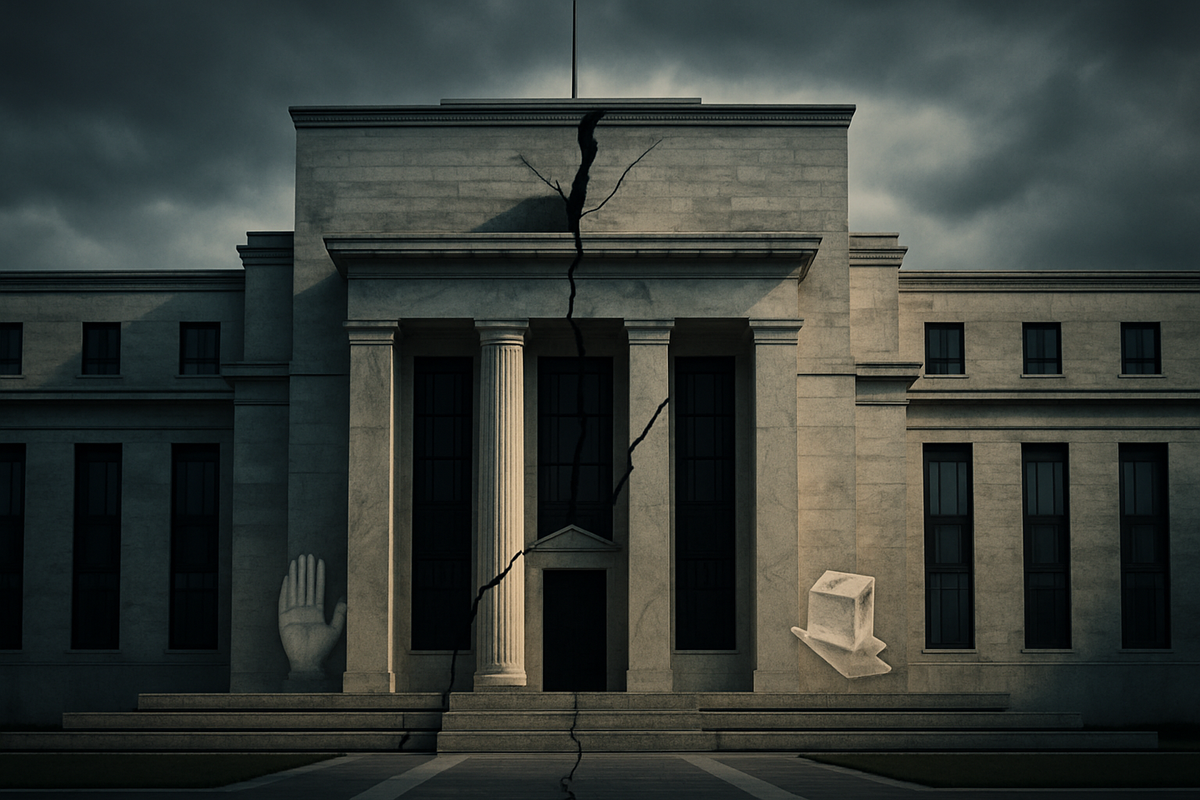
The Federal Reserve finds itself at a critical juncture, grappling with significant internal divisions over the trajectory of interest rates. While a majority of officials have supported recent rate reductions aimed at bolstering a cooling labor market and managing inflation risks, a vocal minority remains cautious, advocating for a more restrictive stance. These mixed signals from the central bank are creating a palpable sense of uncertainty across financial markets, leaving investors, businesses, and consumers to navigate a complex economic outlook. The ongoing debate highlights the challenging balancing act the Fed faces in achieving its dual mandate of maximum employment and price stability.
The immediate implication of these divergent views is a lack of clear guidance on future monetary policy. This ambiguity can lead to increased market volatility, as participants struggle to predict the Fed's next moves. The delicate dance between reining in inflation and preventing an economic downturn is being complicated by differing interpretations of economic data and varying risk tolerances among Federal Open Market Committee (FOMC) members, suggesting a bumpy road ahead for interest rate decisions.
A Divided House: The Fed's Battle Over Monetary Policy
The internal strife within the Federal Reserve regarding interest rate policy has been a defining characteristic of monetary discussions since late 2024, extending prominently into 2025. After a period of holding steady, the FOMC initiated a series of rate cuts in September, November, and December 2024, cumulatively reducing the federal funds rate by 100 basis points. Following a brief pause in the first half of 2025, the easing cycle resumed with another 25-basis-point cut in September 2025, bringing the rate to a range of 4.0%-4.25%.
Despite these moves, the path forward remains contentious. The September 2025 rate cut, for instance, passed with an 11-1 vote, with Governor Stephen Miran notably dissenting in favor of a more aggressive 50-basis-point reduction. Further illustrating the deep chasm, the Fed's "dot plot" – which charts individual members' projections for the federal funds rate – consistently shows a wide dispersion of views. While the median expectation after the September 2025 meeting implied two more cuts by year-end, nearly half of the officials (9 out of 19) preferred only one more cut or none at all, signaling a "higher for longer" preference among a significant segment.
The arguments underpinning these divisions are rooted in differing assessments of the current economic climate. Those advocating for holding rates or exercising greater caution point to persistent inflation concerns, which, despite moderating, remain above the Fed's 2% target. They fear that overly aggressive cuts could re-ignite inflationary pressures, potentially entrenching inflation around its current 3% level. Furthermore, some policymakers express apprehension about the risk of economic overheating, citing a soaring stock market and tight credit spreads as indicators of excessive risk-taking fueled by "easy money."
Conversely, proponents of further rate reductions emphasize a perceived softening in the U.S. labor market. Indicators such as moderating economic activity growth, slowing job gains, and a slightly rising unemployment rate (though still relatively low) have fueled worries about employment risks. Chair Jerome Powell characterized the September 2025 cut as a "risk management cut" aimed at preventing a further slowdown in the labor market or even a potential recession. Lowering rates, they argue, reduces borrowing costs, stimulates spending and investment, and ultimately supports job creation. These mixed signals have led to cautious and volatile market environments, as investors struggle to discern the Fed's true intentions and the broader economic trajectory.
Winners and Losers in a Divided Rate Environment
The Federal Reserve's internal divisions and the resulting uncertainty around interest rate policy have significant implications for various sectors and public companies, creating both potential winners and losers in the financial markets.
Potential Winners:
- Growth Stocks and Technology Companies: If the Fed ultimately leans towards more aggressive rate cuts, growth-oriented companies, particularly in the technology sector, could benefit. Lower interest rates reduce the cost of capital, making it cheaper for companies like Apple (NASDAQ: AAPL), Microsoft (NASDAQ: MSFT), and Amazon (NASDAQ: AMZN) to fund expansion and innovation. Furthermore, lower discount rates increase the present value of future earnings, which disproportionately benefits companies with high growth expectations.
- Real Estate and Homebuilders: A sustained period of lower interest rates typically stimulates the housing market. Mortgage rates tend to track the federal funds rate, albeit with a lag. If rates continue to fall, affordability improves, potentially boosting demand for housing. Companies such as D.R. Horton (NYSE: DHI) and Lennar Corporation (NYSE: LEN) could see increased sales and profitability. Real estate investment trusts (REITs) like Prologis (NYSE: PLG) might also benefit from lower borrowing costs for their property acquisitions and developments.
- Consumer Discretionary: Lower borrowing costs and improved economic sentiment from rate cuts can encourage consumer spending on non-essential goods and services. Retailers, auto manufacturers, and leisure companies could see a boost. Companies like Tesla (NASDAQ: TSLA) or Starbucks (NASDAQ: SBUX) could benefit from increased consumer confidence and purchasing power.
Potential Losers:
- Financial Institutions (Banks): While banks initially benefit from rising rates as their net interest margins expand, sustained rate cuts can squeeze profitability. Lower rates reduce the income banks earn on loans, potentially impacting the bottom line for major institutions like JPMorgan Chase (NYSE: JPM), Bank of America (NYSE: BAC), and Wells Fargo (NYSE: WFC). This is particularly true if the cuts are driven by concerns about economic weakness, which could also lead to an increase in loan defaults.
- Value Stocks and Dividend-Yielding Companies: In an environment of falling rates, the attractiveness of dividend-paying stocks, often considered value plays, can diminish as bonds and other fixed-income instruments become less competitive. While not strictly "losers," their relative performance might lag growth stocks.
- Companies with High Debt (if rates rise unexpectedly): Although the current trend is towards cuts, the internal divisions mean an unexpected hawkish shift is possible. Companies with substantial variable-rate debt could face higher interest expenses if the Fed were to pause or reverse course due to persistent inflation concerns.
The mixed signals from the Fed create a challenging environment for strategic asset allocation, requiring investors to carefully consider their exposure to rate-sensitive sectors.
Broader Implications and Historical Parallels
The Federal Reserve's internal divisions are not merely an academic debate; they carry profound wider significance for the U.S. and global economies. This struggle for consensus fits into broader industry trends marked by persistent inflation, a delicate labor market, and the ongoing recalibration of monetary policy after a period of aggressive tightening. The divergence of opinions among FOMC members underscores the unprecedented complexity of the current economic environment, where traditional indicators offer conflicting signals.
One significant ripple effect is the potential for increased market volatility and investor uncertainty. When the central bank lacks a clear, unified message, it becomes exceedingly difficult for market participants to forecast future economic conditions and policy decisions. This ambiguity can lead to cautious capital allocation, delayed investment decisions, and heightened risk aversion. For example, the bond market, which typically reacts swiftly to Fed expectations, might exhibit erratic movements, impacting everything from corporate borrowing costs to long-term mortgage rates. Competitors and partners across various industries will also face challenges in strategic planning, as the cost of capital and consumer demand remain subject to potential shifts in monetary policy.
Regulatory and policy implications are also substantial. A divided Fed might face increased scrutiny from Congress and the public, potentially leading to calls for greater transparency or even reforms in its decision-making process. Furthermore, the effectiveness of monetary policy itself could be compromised. If the market is unsure of the Fed's commitment or direction, the impact of any rate decision – whether a cut or a hold – might be blunted, making it harder for the central bank to achieve its dual mandate of maximum employment and price stability. Chair Powell's own admission that there are "no risk-free paths" and "it's not incredibly obvious what to do" highlights the inherent difficulty.
Historically, periods of significant internal disagreement within the Fed have often coincided with challenging economic landscapes. For instance, debates during the early 1990s over inflation targeting or during the mid-2000s regarding housing market risks showcased similar tensions. While such divisions are a natural part of a diverse committee, their prominence now signals a period of heightened economic uncertainty, where the path forward is far from clear, and the consequences of missteps could be substantial. The ongoing government shutdown, which has delayed the release of crucial economic data, further complicates the Fed's decision-making process, amplifying the market's reliance on individual officials' remarks and exacerbating the uncertainty.
The Road Ahead: Navigating Monetary Policy's Murky Waters
Looking ahead, the Federal Reserve's internal divisions suggest a period of continued scrutiny and potential volatility for financial markets. In the short term, the market will be closely watching upcoming FOMC meetings, speeches by individual governors, and the release of future "dot plots" for any shifts in sentiment or clearer indications of a consensus. Any surprising vote counts or strongly worded dissents could trigger immediate market reactions. The path for interest rates in late 2025 and early 2026 remains highly uncertain, with scenarios ranging from further gradual cuts to a prolonged pause if inflation proves stickier or the labor market shows unexpected resilience.
Potential strategic pivots for businesses and investors will be crucial. Companies might need to stress-test their financial models against various interest rate scenarios, adjusting capital expenditure plans or debt management strategies accordingly. For instance, businesses with significant expansion plans might consider locking in financing at current rates if they anticipate a potential hawkish shift, while those with variable-rate debt will closely monitor the Fed's every move. Market opportunities could emerge in sectors that are particularly sensitive to interest rates, such as real estate, utilities, and certain financial services, depending on which way the Fed ultimately leans. Conversely, challenges will persist for sectors heavily reliant on consumer confidence or those with high debt burdens, where uncertainty can dampen activity.
Long-term possibilities include a scenario where the Fed eventually achieves a clearer consensus, perhaps driven by more definitive economic data on inflation and employment. However, it's also possible that these divisions persist, leading to a more reactive and less predictable monetary policy approach. This could result in greater market swings and a prolonged period of economic adjustment. Investors should prepare for a landscape where monetary policy decisions are less telegraphed and more subject to real-time economic developments. The interplay between global economic conditions, geopolitical events, and domestic data will continue to shape the Fed's internal debates and, consequently, the future of interest rates.
Conclusion: A Central Bank Divided, a Market in Flux
The Federal Reserve's current internal divisions regarding interest rate cuts represent a significant challenge to its ability to provide clear guidance and maintain market stability. The core takeaway is a central bank grappling with conflicting economic signals – moderating but still elevated inflation versus a cooling labor market – leading to a lack of unified direction on monetary policy. While a majority has supported recent cuts to manage employment risks, a substantial minority remains wary of reigniting inflation, preferring a more cautious approach.
Moving forward, the market will remain in flux, characterized by heightened uncertainty and potential volatility. Investors should anticipate a period where interest rate decisions are less predictable and more responsive to incoming economic data. The absence of a strong consensus within the FOMC means that each economic report and every public statement from a Fed official will be scrutinized for clues about the future path of monetary policy.
What investors should watch for in the coming months includes the evolution of inflation metrics, particularly core inflation, and key labor market indicators such as the unemployment rate and wage growth. The Fed's updated "dot plot" projections and the minutes from future FOMC meetings will be critical in gauging the shifting balance of power and sentiment within the committee. Ultimately, the ability of the Federal Reserve to reconcile its internal differences and articulate a coherent strategy will be paramount in guiding the economy through these uncertain times and restoring confidence in its monetary policy trajectory.
This content is intended for informational purposes only and is not financial advice





